
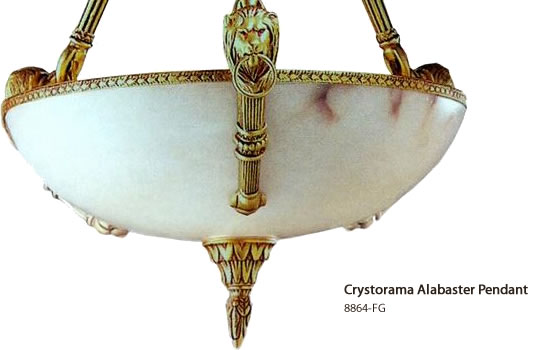
Alabaster is a natural stone that is soft enough to carve. It is not the same thing as the mineral actually called alabaster by geologists.
Two kinds of stone are called alabaster, gypsum and calcite. Both stones can look very similar. To be considered alabaster they have to be translucent, with enough semi-transparency for some light to show through. Gypsum is crystalline hydrated calcium sulfate (CaSo42H2O). Calcite is calcium carbonate (CaCO3). Stalactites and Stalagmites in caves are calcite.
Gypsum Alabaster is the softest. It can be damaged with a fingernail. Calcite Alabaster is harder, but still very easy to carve.
Alabaster occurs naturally in a variety of colors, like marble. But, the type used in lighting is white with beige, taupe or brown veins and inclusions. Pieces used for lamp bases and other small parts might be cut from lower quality, less translucent stone.
Pure alabaster is nearly transparent. The crystals are so small you cannot see them without a microscope. In a mass it looks white. Pure alabaster often forms in areas rich in iron oxide. That is what creates the brown veins or clouds.
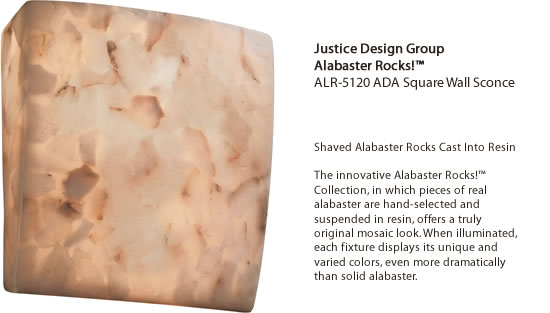
Justice Design Group uses smaller pieces of alabaster to make diffusers for lighting. Pieces of real alabaster are hand-selected and suspended in resin. When illuminated, these fixtures display the unique and varied colors of the alabaster pieces.
The smallest alabaster pieces and alabaster dust are made into alabaster plaster powder.
For centuries these stones have been used to create carvings and bottles and jars for precious things. Very thin sheets of alabaster can even be transparent enough to use as windows.
There are 2 reasons. Limited quantities and high labor.
There is a lot of labor in producing your alabaster lighting.
Alabaster is found in veins between 6" and 20" deep surrounded by other minerals. Alabaster deteriorates when exposed to the surface. Weather damages it, so alabaster found near the surface cannot be used. Alabaster must be mined from deeper sources and it runs in veins only 6" to 20" deep.
Much of the alabaster that is mined cannot be used. Only the translucent stone can be used for lighting. The other is cut away.
Blocks of alabaster are sold to alabaster workshops where they are turned into the diffusers for lighting. Alabaster is either carved or shaped on a lathe.
Once the alabaster is shaped, the piece is sanded. Different grades of sandpaper are used ranging from very rough to very fine. In the final sanding, steel wool leaves a beautiful smooth surface.
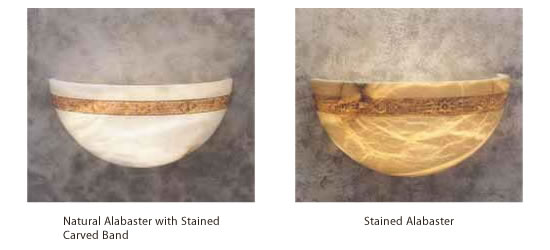
Sometimes stain will be added to shade the alabaster. Stain may be applied to bring out the relief in a carved area. Or the stone may be fully immersed in a dye solution.
Finally, the piece is sprayed with a coat of polyurethane to protect the stone. This finish closes the pores and prevents surface deterioration.
Alabaster has been around for a very long time. Alabaster was used in Bible times. Ancient Egyptian alabaster carvings and vessels can be seen in many museums. The ancient Chinese and Greeks carved alabaster.
Alabaster started to be used for lighting nearly as soon as electric bulbs replaced open flames. Early bulbs were clear and glary. The beautiful translucence of alabaster is the perfect way to hide the bulb and other electric parts and soften its glare.
Alabaster was used in Arts & Crafts, Art Nouveau and Art Deco lighting. In the early 1980s alabaster was rediscovered by modern lighting designers. Alabaster can be seen in many public buildings and homes.
Alabaster is quarried. It is a natural material. Unlike marble or granite, it is found in thin veins only 6" to 20" deep. Marble and granite occur in huge deposits, so they can be cut in matching tiles.
Most alabaster used in lighting comes from
Alabaster is delivered to the factory in huge rocks weighing from 30 pounds to almost a ton. Much of it must be cut away to get to the translucent material that can be used for lighting.
To get the matching pieces for a single chandelier, the larger rocks are cut into slices. They are then cut apart into the sizes necessary for each alabaster piece. They are worked on a lathe to cut out the individual shapes. Up to 75 percent of the rock must be cut away.
It is unusual for any two pieces, even sourced from the same mass, to have the exact same veining. Some may be almost completely milky white and others may have beautiful veining. Craftsmen work to find pieces for a single chandelier that will go together.
If matching really matters to you, you are better off buying a similar look made with a different stone, glass or faux alabaster.
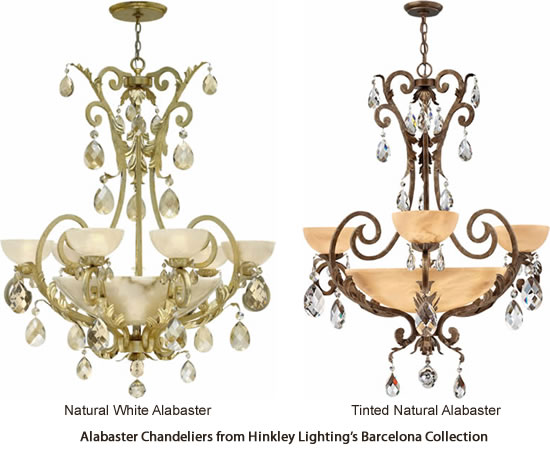
This is easy. Heat evaporates the water from the stone. If the dark area is surrounded by a chalky white ring, it is most likely heat discoloration. Another clue is that it is on the inside and not on the outside, where it was exposed to less heat.
This is a good reason to never use hotter bulbs than your fixture was designed for.
If the dark spot is on the outside or does not have a white chalky ring around it, it is naturally veining.
Simply use a damp - not wet - soft cloth and gently wipe the piece clean. Never use detergents or abrasives.
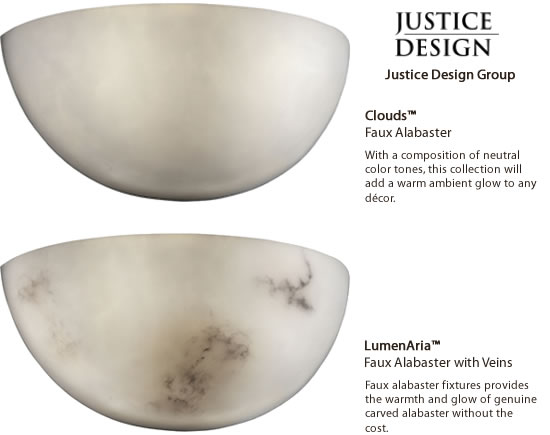
Justice Design Group and other companies make imitation alabaster that is very attractive, less fragile and significantly less expensive. It also matches.
Other stone is made into lighting to looks much like alabaster.
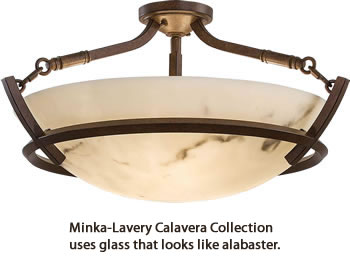
Much of what looks like alabaster is actually glass made to look like alabaster.

design42 New Media Web Design
2192 Dartmouth Rd
Hendersonville NC 28791